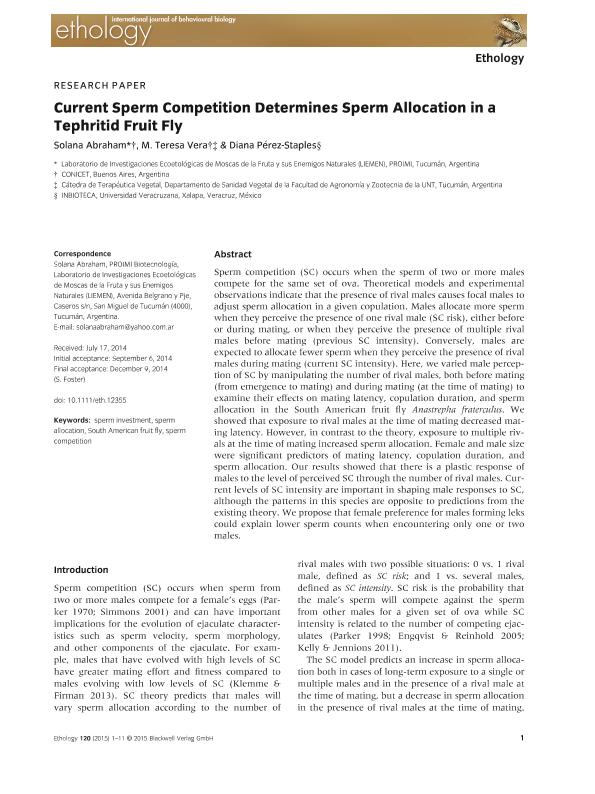Mostrar el registro sencillo del ítem
dc.contributor.author
Abraham, Solana

dc.contributor.author
Vera, Maria Teresa

dc.contributor.author
Pérez Staples, Diana
dc.date.available
2017-02-03T19:47:55Z
dc.date.issued
2015-05
dc.identifier.citation
Abraham, Solana; Vera, Maria Teresa; Pérez Staples, Diana; Current sperm competition determines sperm allocation in a Tephritid Fruit Fly; Wiley Blackwell Publishing, Inc; Ethology; 121; 5; 5-2015; 451–461
dc.identifier.issn
0179-1613
dc.identifier.uri
http://hdl.handle.net/11336/12478
dc.description.abstract
Sperm competition (SC) occurs when the sperm of two or more males compete for the same set of ova. Theoretical models and experimental observations indicate that the presence of rival males causes focal males to adjust sperm allocation in a given copulation. Males allocate more sperm when they perceive the presence of one rival male (SC risk), either before or during mating, or when they perceive the presence of multiple rival males before mating (previous SC intensity). Conversely, males are expected to allocate fewer sperm when they perceive the presence of rival males during mating (current SC intensity). Here, we varied male perception of SC by manipulating the number of rival males, both before mating (from emergence to mating) and during mating (at the time of mating) to examine their effects on mating latency, copulation duration, and sperm allocation in the South American fruit fly Anastrepha fraterculus. We showed that exposure to rival males at the time of mating decreased mating latency. However, in contrast to the theory, exposure to multiple rivals at the time of mating increased sperm allocation. Female and male size were significant predictors of mating latency, copulation duration, and sperm allocation. Our results showed that there is a plastic response of males to the level of perceived SC through the number of rival males. Current levels of SC intensity are important in shaping male responses to SC, although the patterns in this species are opposite to predictions from the existing theory. We propose that female preference for males forming leks could explain lower sperm counts when encountering only one or two males.
dc.format
application/pdf
dc.language.iso
eng
dc.publisher
Wiley Blackwell Publishing, Inc

dc.rights
info:eu-repo/semantics/openAccess
dc.rights.uri
https://creativecommons.org/licenses/by-nc-sa/2.5/ar/
dc.subject
Sperm Investment
dc.subject
Sperm Allocation
dc.subject
South American Fruit Fly
dc.subject
Sperm Competition
dc.subject.classification
Zoología, Ornitología, Entomología, Etología

dc.subject.classification
Ciencias Biológicas

dc.subject.classification
CIENCIAS NATURALES Y EXACTAS

dc.title
Current sperm competition determines sperm allocation in a Tephritid Fruit Fly
dc.type
info:eu-repo/semantics/article
dc.type
info:ar-repo/semantics/artículo
dc.type
info:eu-repo/semantics/publishedVersion
dc.date.updated
2017-02-03T14:00:38Z
dc.journal.volume
121
dc.journal.number
5
dc.journal.pagination
451–461
dc.journal.pais
Estados Unidos

dc.journal.ciudad
Hoboken
dc.description.fil
Fil: Abraham, Solana. Consejo Nacional de Investigaciones Científicas y Técnicas. Centro Científico Tecnológico Tucumán. Planta Piloto de Procesos Industriales Microbiológicos (i); Argentina
dc.description.fil
Fil: Vera, Maria Teresa. Universidad Nacional de Tucumán. Facultad de Agronomía y Zootecnia. Cátedra. Terapéutica Vegetal; Argentina. Consejo Nacional de Investigaciones Científicas y Técnicas; Argentina
dc.description.fil
Fil: Pérez Staples, Diana. Universidad Veracruzana. Instituto de Biotecnologia y Ecologia Aplicada; México
dc.journal.title
Ethology

dc.relation.alternativeid
info:eu-repo/semantics/altIdentifier/doi/http://dx.doi.org/ 10.1111/eth.12355
dc.relation.alternativeid
info:eu-repo/semantics/altIdentifier/url/http://onlinelibrary.wiley.com/doi/10.1111/eth.12355/abstract
Archivos asociados
